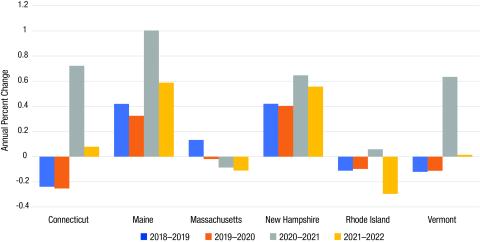Key Findings

The population of New Hampshire grew by 7,700 (0.55 percent) to 1,395,000 between July of 2021 and July of 2022, according to new Census Bureau estimates. New Hampshire’s population gain was the second largest in New England (Figure 1). The population gain was entirely due to migration. In all, 10,200 more people moved into New Hampshire than left between July of 2021 and July of 2022. Nearly 62 percent of this migration gain was because more people moved here from other states than left, but the state also gained from immigration. This migration gain was large enough to offset a natural loss of 2,000 people when deaths exceeded births in New Hampshire in the past year.1 COVID certainly contributed to this loss, but annual deaths already exceeded births in the state before the pandemic. Four New England states had more deaths than births in the past year. Only Connecticut and Massachusetts had more births than deaths. Connecticut grew from this excess of births over deaths and from a migration gain. New Hampshire, Maine, and Vermont gained population because they had a large enough influx of migrants to offset the excess of deaths over births. In contrast, Rhode Island lost population both because it had more deaths than births and because it lost migrants. Massachusetts also lost population even though it had more births than deaths, because more people left the state than moved to it. Overall, New England’s population gain in the past year was only .06 percent compared to a U.S. gain of .38 percent. Both these population gains are low compared to historical trends.
Annual Population Percentage Change for New England States, 2018 to 2022

Analysis: K.M. Johnson, Carsey School, University of New Hampshire. Source: U.S. Census Bureau Population Estimates released 12/22/22. Note: This analysis is based on population estimates and should be interpreted with caution.
1. Census Bureau estimates of natural change (births-deaths), population, and migration are made using independent models, so they do not always sum to the total estimated population change. The difference is reported as a residual in Census Bureau databases, but not included here.

Kenneth M. Johnson is senior demographer at the Carsey School of Public Policy, professor of sociology at the University of New Hampshire, and an Andrew Carnegie Fellow. His research was supported by the NH Agricultural Experiment Station through joint funding from the USDA National Institute of Food and Agriculture (under Hatch-Multistate project W5001, award number 7003437) and the state of New Hampshire. The opinions are his and not those of the sponsoring organizations. The research assistance of Tyrus Parker is gratefully acknowledged.